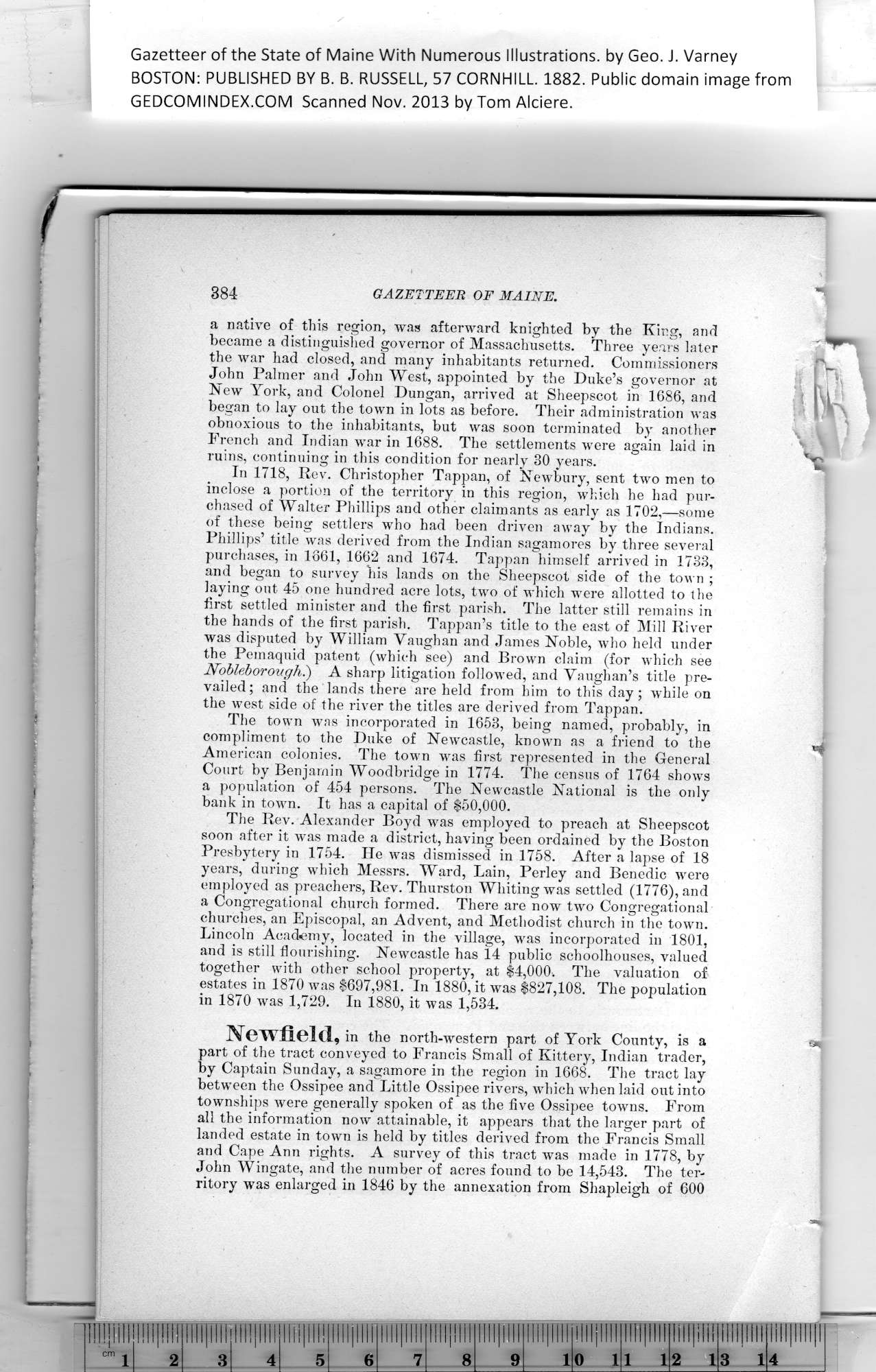|
Gazetteer of the State of Maine With Numerous Illustrations, by Geo. J. Varney
BOSTON: PUBLISHED BY B. B. RUSSELL, 57 CORNHILL. 1882. Public domain image from
384 GAZETTEER OF MAINE.
a native of this region, was afterward knighted by the King, and
became a distinguished governor of Massachusetts. Three years later
the war had closed, and many inhabitants returned. Commissioners
John Palmer and John West, appointed by the Duke’s governor at
New York, and Colonel Dungan, arrived at Sheepscot in 1686, and
began to lay out the town in lots as before. Their administration was
obnoxious to the inhabitants, but was soon terminated by another
French and Indian wrar in 1688. The settlements were again laid in
ruins, continuing in this condition for nearly 30 years.
In 1718, Rev. Christopher Tappan, of Newbury, sent two men to
inclose a portion of the territory in this region, which he had pur-
chased of Walter Phillips and other claimants as early as 1702,—some
of these being settlers who had been driven away by the Indians.
Phillips’ title was derived from the Indian sagamores by three several
purchases, in 1861, 1662 and 1674. Tappan himself arrived in 1733,
and began to survey his lands on the Sheepscot side of the town ;
laying out 45 one hundred acre lots, two of which were allotted to the
first settled minister and the first parish. The latter still remains in
the hands of the first parish. Tappan’s title to the east of Mill River
was disputed by William Vaughan and James Noble, who held under
the Pemaquid patent (which see) and Brown claim (for which see
JSfobleborough.') A sharp litigation followed, and Vaughan’s title pre-
vailed; and the lands there are held from 1dm to this day; while on
the west side of the river the titles are derived from Tappan.
The town was incorporated in 1653, being named, probably, in
compliment to the Duke of Newcastle, known as a friend to the
American colonies. The town was first represented in the General
Court by Benjamin Woodbridge in 1774. The census of 1764 shows
a population of 454 persons. The Newcastle National is the only
bank in town. It has a capital of $50,000.
The Rev. Alexander Boyd was employed to preach at Sheepscot
soon after it was made a district, having been ordained by the Boston
Presbytery in 1754. He was dismissed in 1758. After a lapse of 18
years, during which Messrs. Ward, Lain, Perley and Benedic were
employed as preachers, Rev. Thurston Whiting was settled (1776), and
a Congregational church formed. There are now two Congregational
churches, an Episcopal, an Advent, and Methodist church in the town.
Lincoln Academy, located in the village, was incorporated in 1801,
and is still flourishing. Newcastle has 14 public schoolhouses, valued
together with other school property, at $4,000. The valuation of
estates in 1870 was $697,981. In 1880, it was $827,108. The population
in 1870 was 1,729. In 1880, it was 1,534.
Newfield, in the north-western part of York County, is a
part of the tract conveyed to Francis Small of Kittery, Indian trader,
by Captain Sunday, a sagamore in the region in 1668. The tract lay
between the Ossipee and Little Ossipee rivers, which when laid out into
townships were generally spoken of as the five Ossipee towns. From
all the information now attainable, it appears that the larger part of
landed estate in town is held by titles derived from the Francis Small
and Cape Ann rights. A survey of this tract was made in 1778, by
John Wingate, and tbe number of acres found to be 14,543. Tbe ter-
ritory was enlarged in 1846 by the annexation from Shapleigh of 600
PREVIOUS PAGE ... NEXT PAGE
This page was written in HTML using a program written in Python 3.2
|
